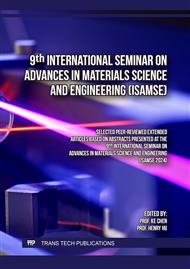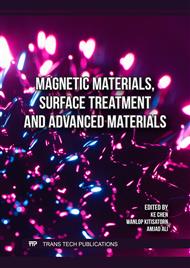[1]
C. Wu, B. Ma, and G. Zhao. Effect of Delayed Quenching on the Microstructure and Properties of TC4 Titanium Alloy for Aerospace Fasteners, J. Journal of Heat Treatment of Metals. 48 (12) (2023) 135-139.
Google Scholar
[2]
Y. Liu, J. Chen, X. Zhang, and D. Tan. "Fatigue behavior of blind bolts under tensile cyclic loads", Journal of Constructional Steel Research, Vol. 148, pp.16-27, 2018.
DOI: 10.1016/j.jcsr.2018.05.019
Google Scholar
[3]
R. Xing, B. Qiu, and H. Lei. "Experimental Study on Fatigue Performance of M24 Twisted-Shear High-Strength Bolt for Assembled Steel Structure", Applied Sciences, Vol. 13, No. 7, p.4, 296, 2023.
DOI: 10.3390/app13074296
Google Scholar
[4]
E.M. Hassan, H. Mahmoud, G. Riveros, and S. Lopez. "Multi-axial fatigue behavior of high-strength structural bolts", Journal of Constructional Steel Research, Vol. 205, p.107, 912, 2023.
DOI: 10.1016/j.jcsr.2023.107912
Google Scholar
[5]
J. Diller, J. Blankenhagen, D. Siebert, C. Radlbeck, and M. Mensinger. "Combined effect of surface treatment and heat treatment on the fatigue properties of AISI 316L, manufactured by powder bed fusion of metals using a laser (PBF-LB/M) ", International Journal of Fatigue, Vol. 178, p.108, 025, 2024.
DOI: 10.1016/j.ijfatigue.2023.108025
Google Scholar
[6]
M. Baklouti, R. Mnif, and R. Elleuch. "Impact of surface hardening treatment generated by shot peening on the fatigue life of brass alloy", Journal of Mechanical Science and Technology, Vol. 26, No. 9, p.2, 711-2, 717, Sep. 2012.
DOI: 10.1007/s12206-012-0738-3
Google Scholar
[7]
Kido R. et al. "Effects of Surface Treatment on Fatigue Property of A5052-H14 and A2017-T4 Aluminum Alloys", Journal of the Japan Institute of Metals and Materials, Vol. 84, No. 3, pp.74-79, 2020.
DOI: 10.2320/jinstmet.JB201904
Google Scholar
[8]
J. Wu et al. "Effect of shot peening forming and shot peening strengthening post-treatment on the fatigue behavior of bolt-connected 2024HDT alloy", Engineering Fracture Mechanics, Vol. 293, p.109, 690, 2023.
DOI: 10.1016/j.engfracmech.2023.109690
Google Scholar
[9]
Z. Zhang, Y. Zhang, Z. Zhang, and G. He. "Effect of brittle TiN coating on fatigue performance of TC11 titanium alloy under rotating bending and tension-tension", Journal of Alloys and Compounds, Vol. 968, p.172, 163, 2023.
DOI: 10.1016/j.jallcom.2023.172163
Google Scholar
[10]
W. Dai et al. "A review on the fatigue performance of micro-arc oxidation coated Al alloys with micro-defects and residual stress", Journal of Materials Research and Technology, Vol. 25, p.4, 554-4, 581, 2023.
DOI: 10.1016/j.jmrt.2023.06.244
Google Scholar
[11]
S. Hosseini, M. Farajollahi, and M. Ebrahimi. "Residual stress, fatigue behavior, and mechanical properties of equal-channel angular pressed commercial pure titanium", Journal of Materials Research and Technology, Vol. 28, p.3, 297-3, 305, 2024. Doi: https://doi.org/.
DOI: 10.1016/j.jmrt.2023.12.265
Google Scholar
[12]
R. Su et al. "Factors Influencing Residual Stresses in Cold Expansion and Their Effects on Fatigue Life-A Review", Coatings, Vol. 13, No. 12, 2023.
DOI: 10.3390/coatings13122037
Google Scholar
[13]
R.T.R. McGrann, D. J. Greving, J. R. Shadley, E. F. Rybicki, T. L. Kruecke, and B. E. Bodger. "The effect of coating residual stress on the fatigue life of thermal spray-coated steel and aluminum", Surface and Coatings Technology, Vol. 108-109, pp.59-64, 1998.
DOI: 10.1016/S0257-8972(98)00665-3
Google Scholar
[14]
Y. Bai et al. "Brittle coating effects on fatigue cracks behavior in Ti alloys", International Journal of Fatigue, Vol. 125, pp.432-439, 2019. Doi: https://doi.org/10.1016/ j.ijfatigue.2019.04.017.
DOI: 10.1016/j.ijfatigue.2019.04.017
Google Scholar



